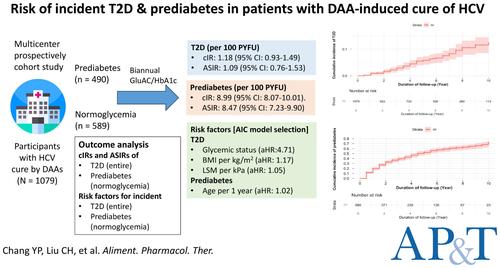Risk of Incident Type 2 Diabetes and Prediabetes in Patients With Direct Acting Antiviral-Induced Cure of Hepatitis C Virus Infection
Abstract
Background
Data regarding the risk of incident type 2 diabetes (T2D) and prediabetes among patients with hepatitis C virus (HCV) achieving direct-acting antivirals (DAAs)-induced sustained virologic response (SVR12) remains limited.
Methods
A total of 1079 patients, including 589 with normoglycemia and 490 with prediabetes, who underwent biannual fasting glucose and glycosylated haemoglobin (HbA1c) assessment for a median post-SVR12 follow-up of 5.5 years, were enrolled. We reported the crude (cIRs) and age-standardised incidence rates (ASIRs) of T2D and prediabetes. Factors associated with incident T2D and prediabetes were assessed using the Cox proportional hazards models.
Results
The cIRs of T2D and prediabetes were 1.18 and 8.99 per 100 person-years of follow-up (PYFU), respectively. Additionally, the ASIRs of T2D and prediabetes were 1.09 (95% CI: 0.76–1.53) and 8.47 (95% CI: 7.23–9.90) per 100 PYFU. Prediabetes (adjusted hazard ratio [aHR]: 4.71; 95% confidence interval (CI): 2.55–8.70, p < 0.001), body mass index (BMI) per kg/m2 increase (aHR: 1.17; 95% CI: 1.09–1.26, p < 0.001) and liver stiffness measurement (LSM) per kPa increase (aHR: 1.05; 95% CI: 1.02–1.09, p = 0.001) were associated with a higher risk of incident T2D. Age per year increase (aHR: 1.02; 95% CI: 1.01–1.03, p < 0.001) was associated with a higher risk of incident prediabetes.
Conclusion
The incidence rates of T2D and prediabetes remain substantial among patients after HCV eradication. Lifestyle modification, drug therapy and regular monitoring of glycemic status are crucial for patients at risk of developing T2D and prediabetes following HCV clearance.


 求助内容:
求助内容: 应助结果提醒方式:
应助结果提醒方式:


